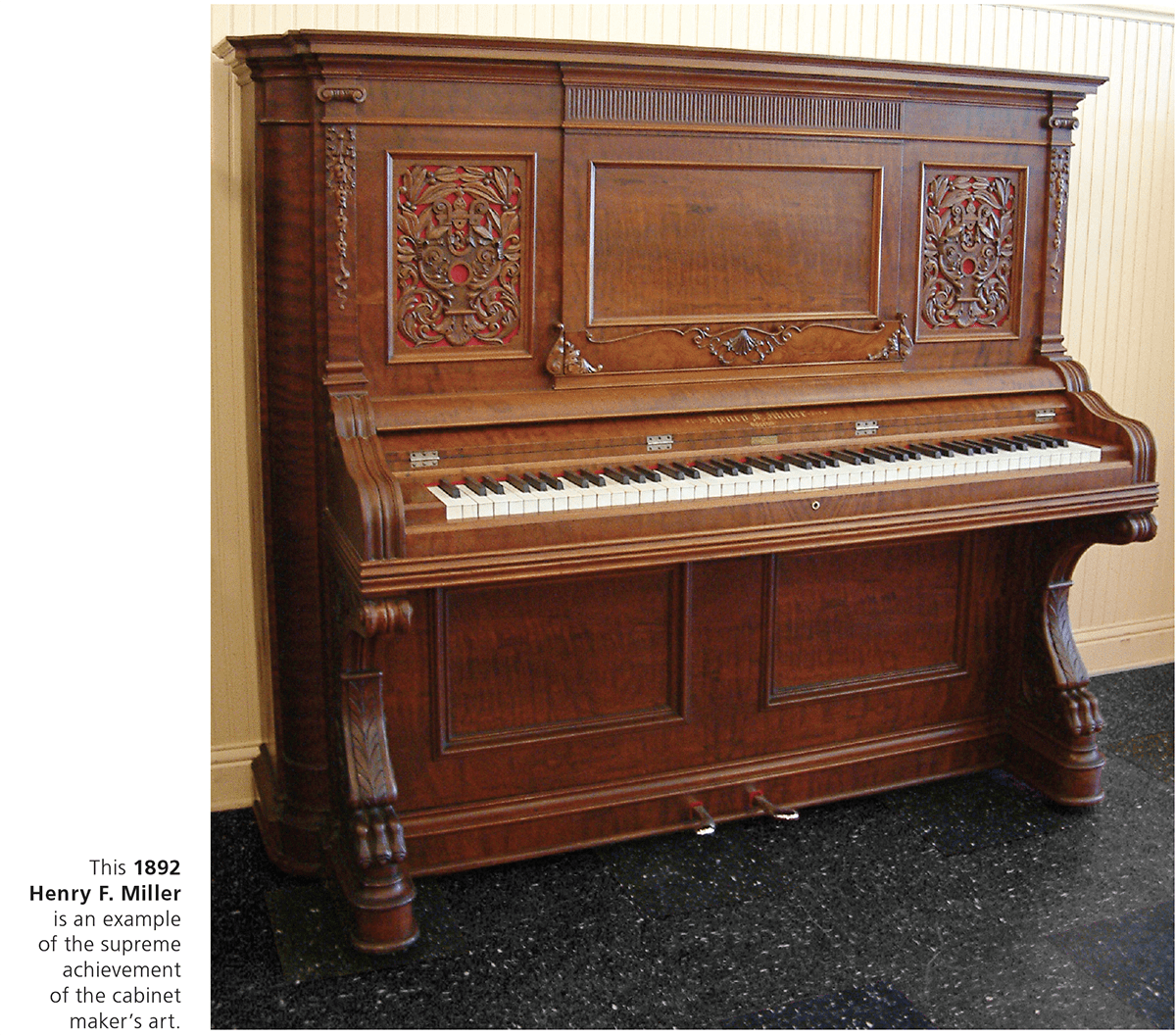
The Piano's Various Forms
The original harpsichord shape of the piano gradually evolved into today's grand piano shape in order to meet the acoustical needs of concert halls and the musical demands of professionals and dedicated amateur players. In the process, the piano became a status symbol for the upper classes. With the rise of a middle class during the Industrial Revolution, the opportunity to learn to play the piano, and to appreciate and own the finer things in life, became available to large numbers of people for the first time.
In the mid-19th century, the square piano, also known as the square grand, constituted the largest share of the American piano market. Although often a beautiful piece of furniture, the square's oblong, rectangular shape was a manufacturing and design nightmare due to its limited ability to withstand the tension of the strings. This and other faults, including its large size, contributed to the beginning of its demise, in favor of the upright, soon after the Civil War. Uprights were cheaper to manufacture, which made them more affordable; and, being smaller, they fit better in the narrower dwellings of the middle class, who constituted the new generation of piano owners. By 1890, square pianos had all but disappeared from piano showrooms.
Although not a piano, the reed organ, also known as the pump organ, reigned as the most popular keyboard instrument for the home from 1850 to 1894. It was inexpensive, easy to manufacture, and durable. However, as improved manufacturing methods led to lower piano prices, the public turned away from the reed organ in favor of the piano. Many notable piano manufacturers, including Mason & Hamlin, Baldwin, and Kimball, got their start making reed organs.
Since 1880, the most historically significant form of the piano has been the upright. Eminently affordable, uprights were made by the millions, and countless specimens made between 1880 and 1930 still exist to be admired and studied. The upright, like the grand, reached its current technical design around 1880. Because of this, although the furniture of an 1880s upright may be considered antique, such a piano is considered mechanically modern.
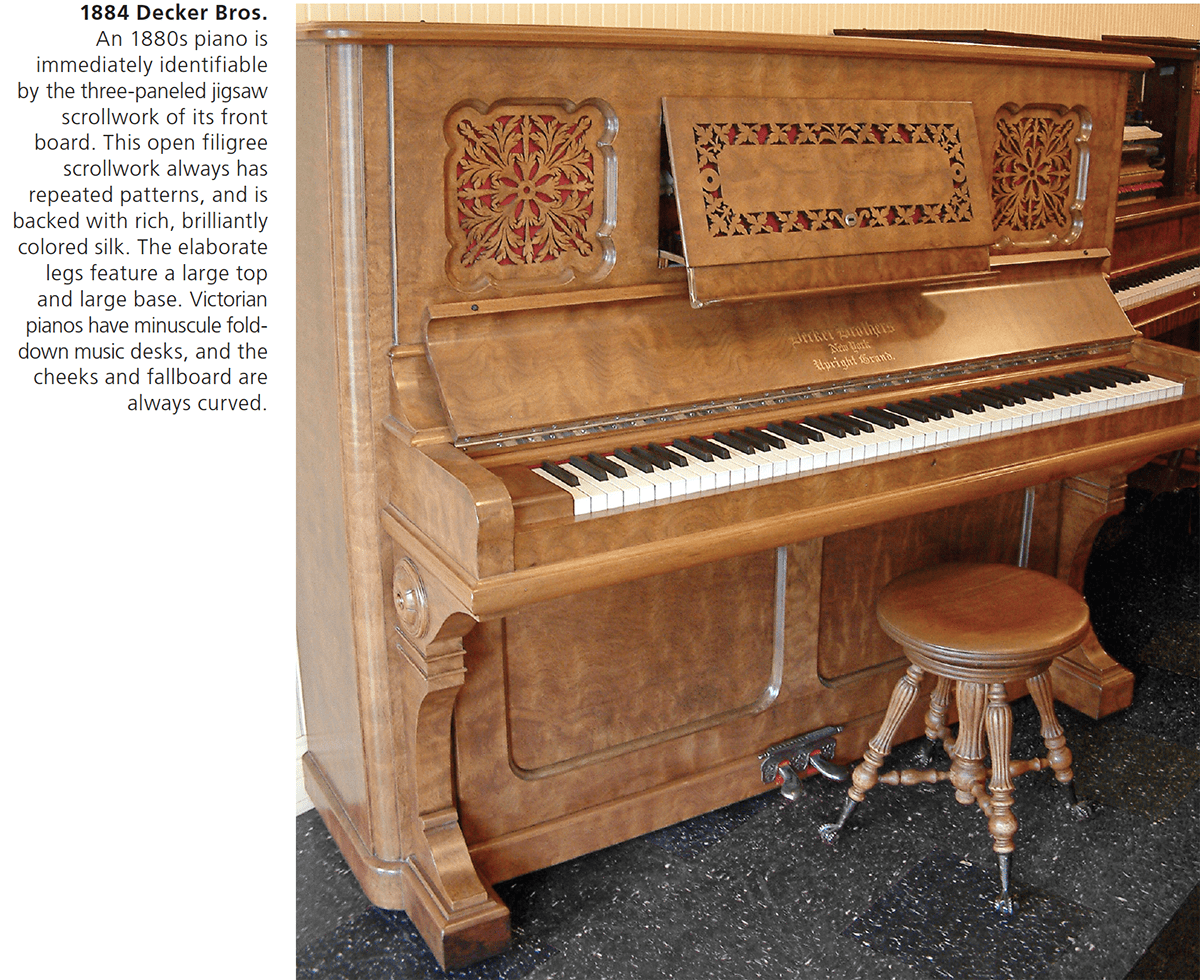
The Industrial Revolution in America
The Industrial Revolution took root in America in the late 1860s, following the Civil War. The biggest technological advancement was the displacement of water power by steam power, which allowed industry to move away from the banks of fast-moving rivers in the Northeast and spread across the nation. Coal was increasingly used to fuel the new steam engines and to heat the factories. These factories were generally located in cities, which were crowded with foreign immigrants and rural Americans seeking the jobs made possible by the Industrial Revolution, and which thus had an abundant supply of cheap labor.
Early in this period, most piano manufacturers were located in Eastern cities such as New York, Boston, and Baltimore. As railroads opened up the West, Chicago retailers supplied the emerging frontier towns with pianos from the East. Eventually, these towns grew large enough to bypass the Chicago merchants and deal directly with Eastern manufacturers. In response, a number of Chicago retail firms, such as Lyon & Healy and W.W. Kimball, began to make their own pianos and thus challenge the dominance of the Eastern makers. Because labor unions had yet to organize there, pianos made in Chicago were cheaper, though many were also of mediocre quality.
By the 1880s, the adoption of mass production and assembly-line techniques led to extraordinary price reductions in goods of all kinds, including pianos. To expand the market, retailers adopted installment sales, a practice pioneered by the Singer Sewing Machine Company; by the 1890s, the vast majority of pianos were sold on installment credit.
During this later period, some piano makers made most of their own parts and kept their quality standards high. Some of the better-known names included Steinway, Chickering, Henry F. Miller, Vose, and Weber. But most of the several hundred piano manufacturers active in this period merely assembled parts supplied by other firms that specialized in making soundboards, plates, actions, hardware, and cabinet components. Some of these assembly shops produced nice pianos, and proudly had their names cast into the plates. Others sold their pianos on a "stencil basis"; that is, the pianos bore no brand name or manufacturer identification. Typically, the dealer would place on the instrument a decal with the name of his store. Sometimes, however, an unscrupulous dealer would use a name nearly identical to that of a high-end piano, in order to dupe customers into believing that, say, a "Stienway" was actually a Steinway. Stenciled pianos were generally of low quality, and were a constant source of aggravation for the makers of high-quality instruments.
The Victorian Period
The term Victorian generally describes British society from 1837 to 1901, the years of the reign of Queen Victoria; or, in America, the late 19th century. However, the term defines a collection of interrelated attitudes more than an actual time span, and conjures up images of prudery, domesticity, sentimentality, social conservatism, romanticism, fussy and overfurnished parlors, middle-class stuffiness, and the opulence of an upper class of super-rich industrialists.
Recall the world that had come before. In America, many had lived on the frontier, with only the objects necessary for daily subsistence. The new, urban-based industrial age created an abundance of work for the newly arrived immigrants. There was a significant increase in wages for laborers and clerical workers alike, which in turn led to the formation of a growing class of individuals who were comfortable but not rich. The industrial age produced a new materialistic view of the world that encouraged people to consume as much as they could, and people began to collect things.
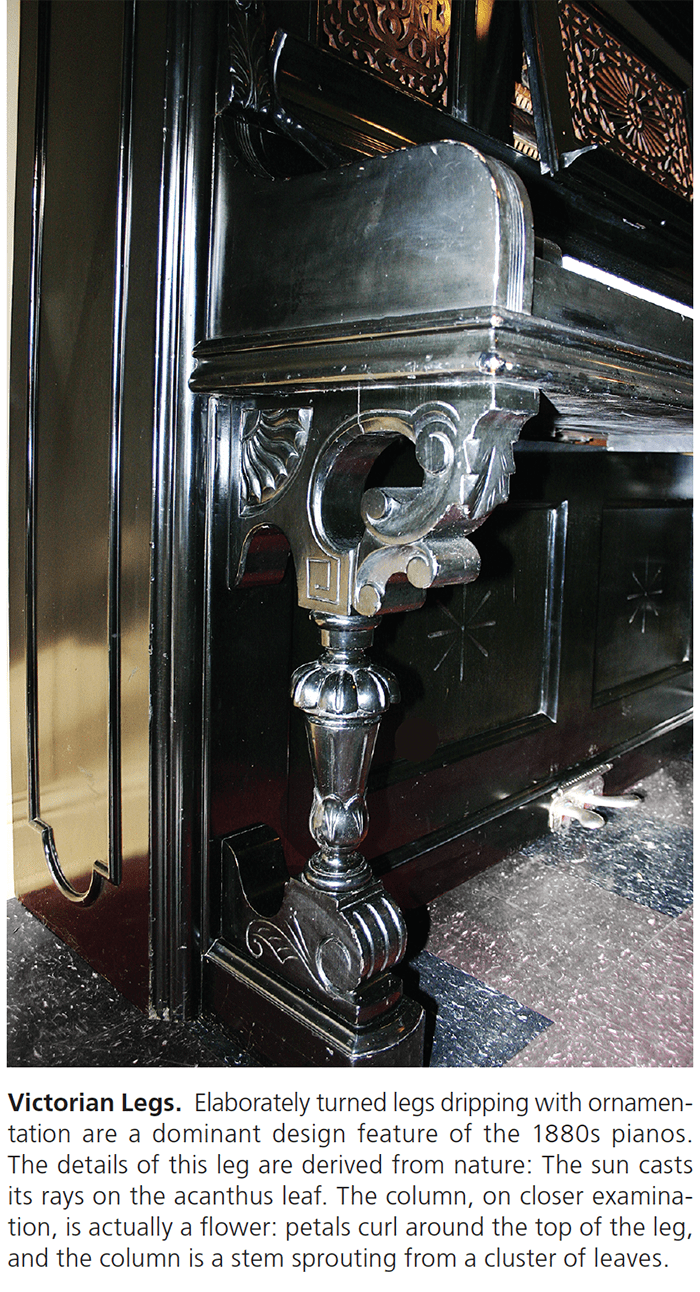
One of the most coveted objects was a piano, which symbolized the middle-class values of the Victorian age — not only the virtues attributed to music, but also of home and family life, respectability, and a woman's place and duty. Music making and music appreciation became feminized. For a family to own a piano, and to have its daughters play the instrument (whether or not they wanted to or had any musical talent), became an emblem of prosperity. It was a fashionable and convenient way to introduce a young lady to society and, if she was lucky, attract a wealthy husband. This glorification of the piano was no mere fad; the instrument became a moral institution. By 1886, seven out of ten pupils in the U.S. public schools were being taught to read music, and it is estimated that there were a half million piano students in the country.
Although Queen Victoria had little to do with the American furniture style named for her, the association persists, and conveys a meaning. Victorian furniture designers drew inspiration for their work from a variety of other eras; most noteworthy among these were the gothic (12th to early 16th centuries) and the rococo (18th century). The style was eclectic, ornate in design, and, some would say, cluttered. Homes were filled to the brim with big furniture and excessive amounts of ornamentation. Victorian pianos are instantly recognizable: they had lots of curves, glossy finishes with rounded corners, and flamboyant ornamentation — the more the better. American Victorian-era piano design was split into two main phases: the styles of the 1880s and those of the 1890s.*
Styles of the 1880s
An 1880s piano is immediately identifiable by the three-paneled jigsaw scrollwork of its front board. This open filigree scrollwork always has repeated patterns, and is backed with rich, brilliantly colored silk. The fabric's purpose is twofold: it displays the design of the scrollwork, and permits the music to radiate out from the piano's interior toward the player, for a much more present sound.
The elaborately turned legs feature a large top and large base dripping with ostentatious ornamentation. Also, Victorian pianos had minuscule fold-down music desks, either attached to the curved fallboard, or located on the bottom edge of the front board's center panel.
The woods were highly figured veneers, predominately of mahogany and rosewood.Repeating patterns of rococo involute carving extend from the pilaster onto the cheek, appearing as if squeezed from a tube of cake frosting. The sides of these early pianos were also often curved or paneled.
Styles of the 1890s
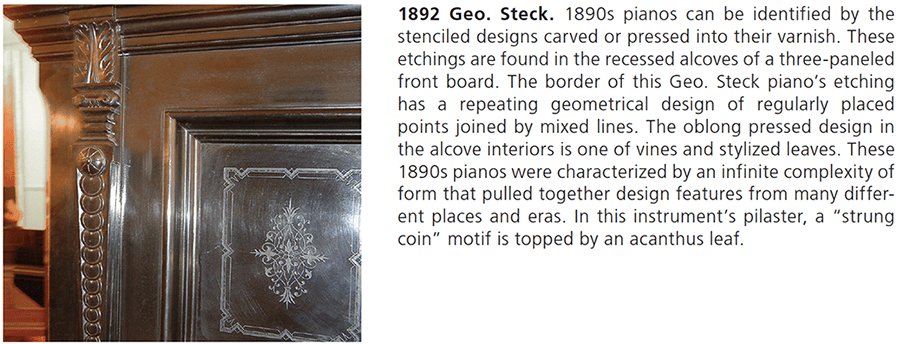
The decade of the 1890s was, economically, a generally depressed period that included two monetary panics; growth did not resume until about 1898. The 1893 panic, a global collapse of the value of U.S. currency caused by a partial abandonment of the gold standard, was short-lived, but in some ways hit the nation harder than did the Great Depression of the 1930s. Manufacturing came to a near standstill — in 1894, in response to a precipitous drop in demand for pianos, piano production plummeted by more than 50 percent, and manufacturers slashed salaries. The panic also fostered protectionist and anti-immigrant sentiment.
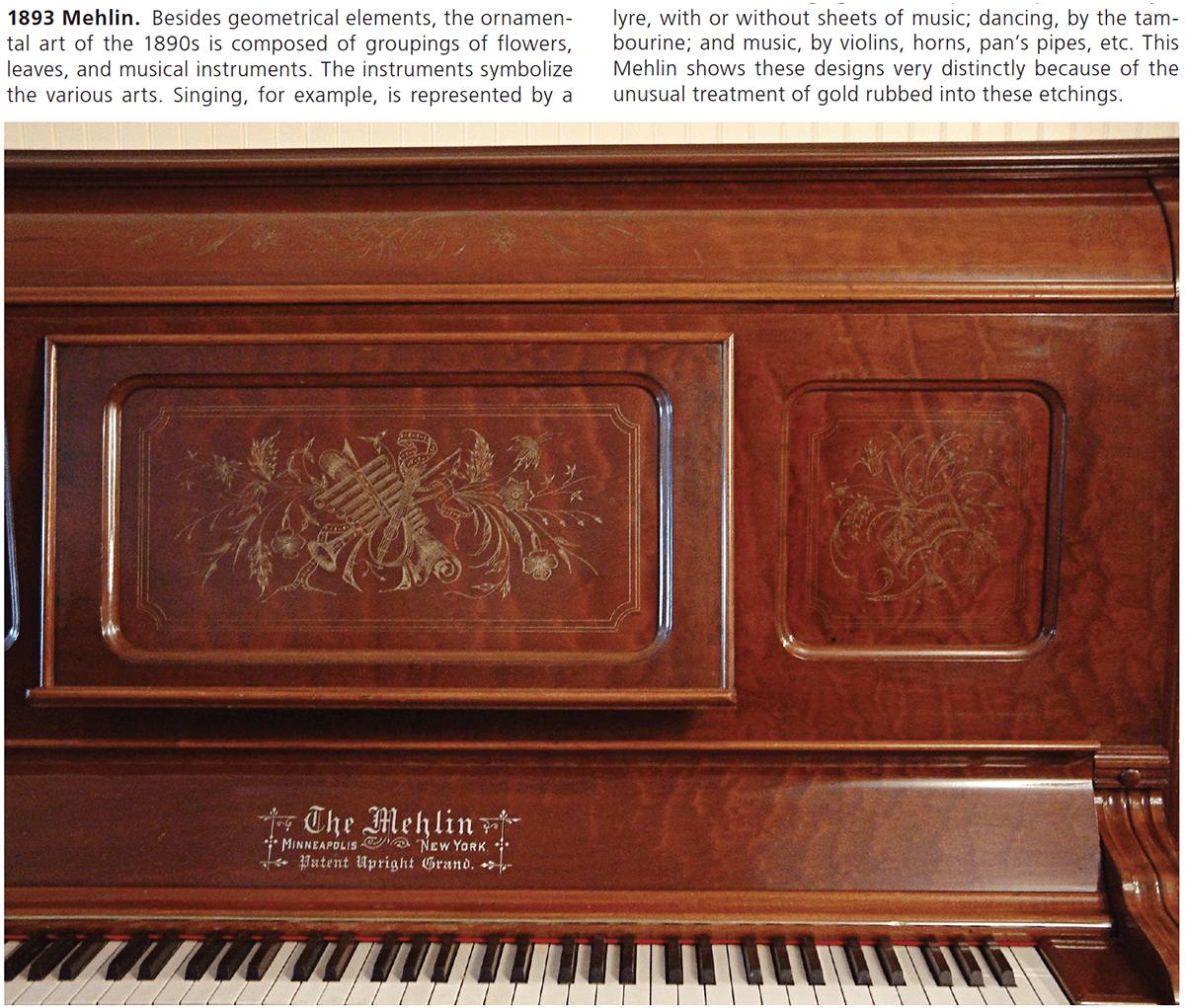
To reduce costs, some of the more labor-intensive furniture designs were simplified. Intricate jigsawn front panels were replaced by stenciled etchings, usually of other musical instruments, carved into the varnish. The decorative motifs ranged widely, from classical designs to floral patterns to repetitive geometric forms. The ebonized finish first appears in this decade, as it was less expensive to finish a piano in black than in a wood finish. However, legs were still heavily ornamented, though not as lavishly as in the 1880s, with a large base and top (long, columnar legs didn't appear until the 1900s). The music desk is still tiny, the fallboard and cheeks are curved, and the cheeks are sometimes carved. Higher-end models of the 1890s still have the lavish carvings and highly figured veneers of the 1880s.
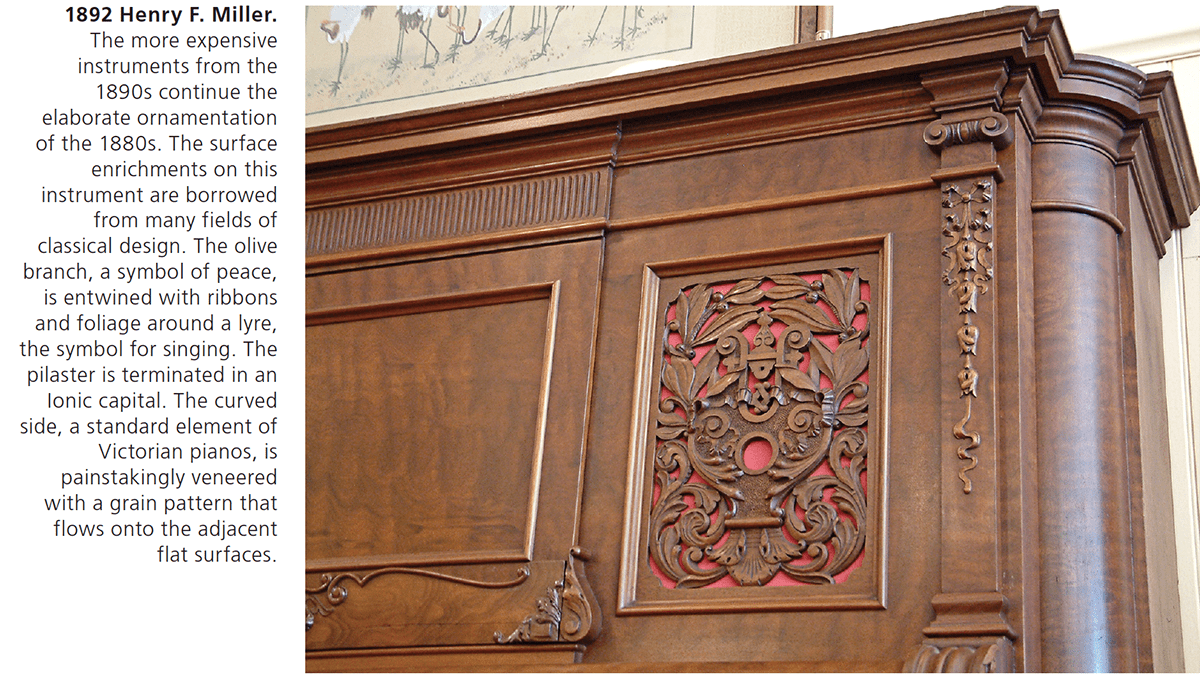
Changing Mores
The Chicago Columbian Exposition of 1893, dedicated to displays of technological advancement and a precursor of the World's Fairs of the 20th century, was visited by 12.5 million people, or about 20 percent of the U.S. population at that time. The piano manufacturers' displays there stimulated piano sales and amateur musicianship, and hastened the demise of the reed organ.
The Columbian Exposition came at a time of strict social mores and sexual restraint. The new music introduced there consisted of gayer, more vulgar tunes than any previously played in American parlors. These syncopated melodies soon became ragtime, a forerunner of jazz. With advances in the printing of sheet music, formerly oriented mostly toward professional musicians, the family piano became the center of an enormous business in sheet music, eventually known as Tin Pan Alley, that sold these peppy tunes. The popularity of ragtime, and its greater availability through sheet music, contributed to the breakdown of Victorian attitudes and the ushering in of a new social era as the 19th century came to a close.
Player Pianos
Beginning in 1889, scores of inventions for an automated piano began appearing. Sales of player pianos really took off in 1905, when a standardized piano song roll was designed that could be used in instruments made by different companies. Player pianos were amazing machines that altered the nation's musical and social landscapes. For one thing, through rolls of punched paper, ragtime music, originally composed and played only by black musicians, could now be played in the homes of white middle-class Americans. For another, unprecedented numbers of nonmusicians were now being exposed to music. The player-piano industry was big business. It is estimated that, by 1918, 800,000 player pianos were in operation east of the Mississippi River.
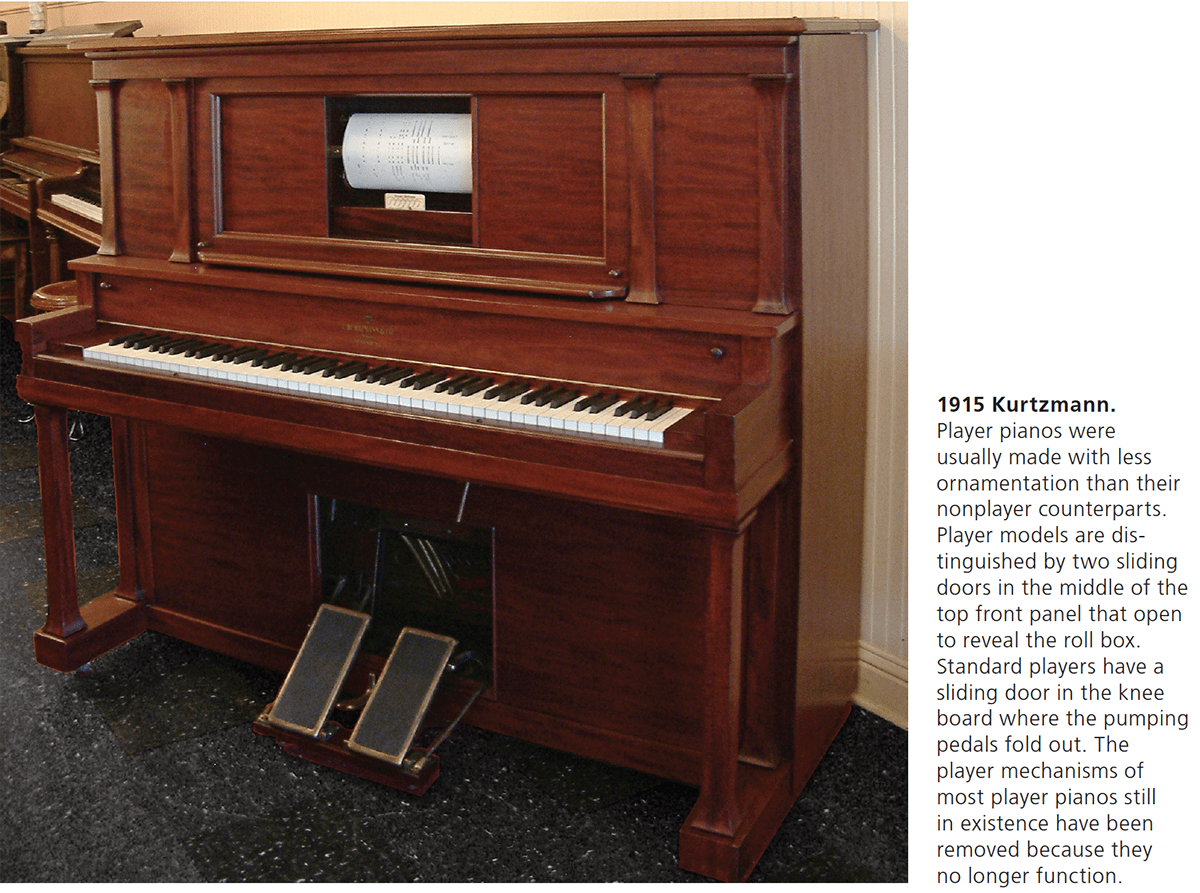
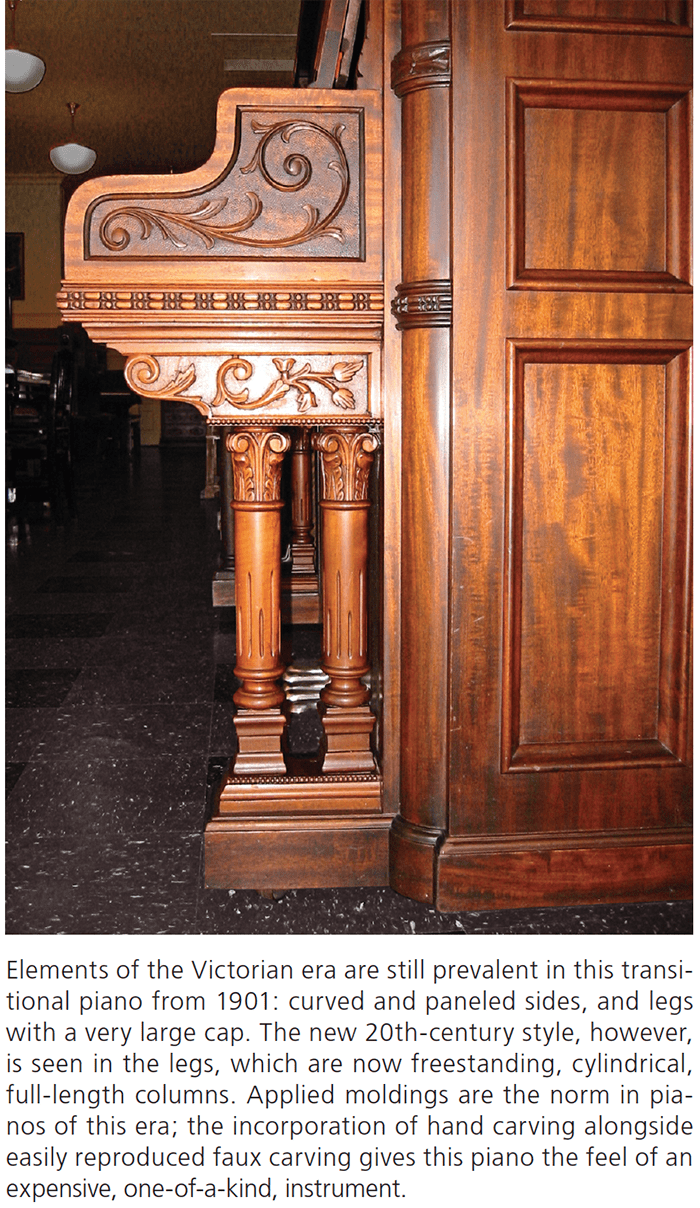
Most player pianos were "standard" models — that is, they played at a single volume and a single speed. One would sit at the piano, pumping the foot-operated bellows. To add expression to the music, one could manipulate the loud/soft and fast/slow levers. There was also a phenomenal device called a reproducing piano, which could reproduce an artist's full range of virtuosity — the nuances, the phrasing, the dynamics. For 30 years, practically all of the great artists recorded rolls for these pianos, including Johann Strauss, Béla Bartók, Gustav Mahler, and Ignace Paderewski. Reproducing-piano mechanisms were placed in high-end pianos, such as grand and upright models from Steinway and Mason & Hamlin, and were considered the advanced recording technology of their day.
Upright player pianos are easily identified by a sliding two-door panel in the front board. The hinged keyslip pivots open to expose the control levers. Standard players have a door above the pedals. The case designs follow the characteristics of the era in which they were made, though usually with less ornamentation than their nonplayer counterparts.
A New Century
At the dawn of the 20th century, the piano was found at all levels of American society. It had become a significant piece of middle-class furniture — a necessary accessory to domesticity, and as familiar as the armchair. Before the bathroom became the shrine of the American home, there were more pianos and organs in this country than bathtubs.
Molds
A major change affecting case styles of the early 1900s came with the application to piano manufacturing of the composition mold. These molds allowed what looked like painstakingly intricate hand carvings to be inexpensively and easily reproduced. A design pattern was carved in wood just once, and a mold was then formed over the carving to create a negative of the original. A paste of animal glue, linseed oil, resin, and sawdust was then poured into this mold to make a precise replica of the original carving. Apply a faux finish, and voilà — it looks like a hand carving.
Two types of raised-design moldings are found on pianos of the early 20th century. One type consists of a panel that has been molded in its entirety, with all of its raised designs already part of the mold. The entire panel then needed to be faux finished. More commonly, individual design elements were cast from molds, then applied with nails or glue to the piano's front board and/or its columns and legs. The most convincing applied moldings are those that are interspersed with genuine carvings.
Styles of 1900–1909
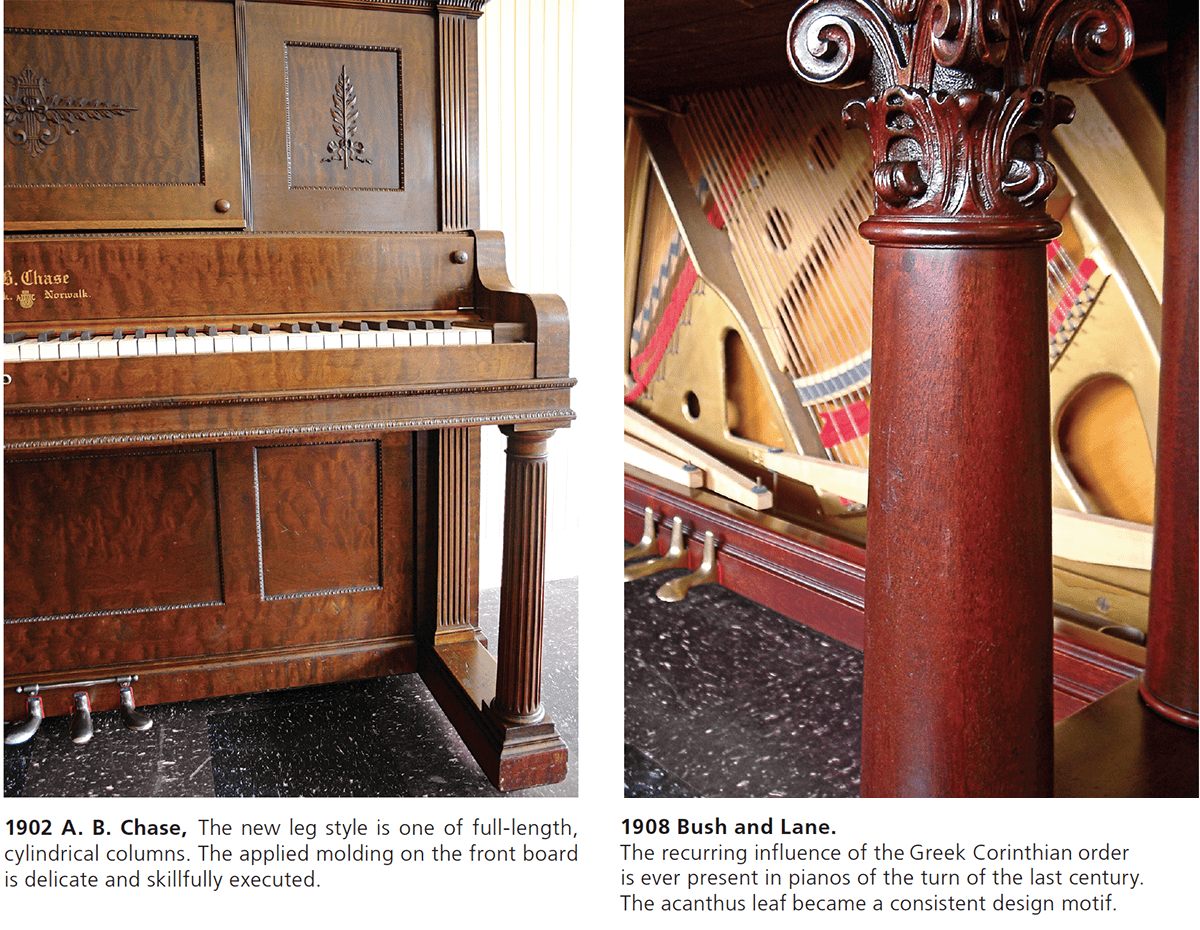
There were several major design changes in the pianos of the early 20th century. Instruments made in this decade are easily identifiable by the applied moldings on the front board.
Gone are the top-heavy legs; the pianos now had full-length columns for legs. Turn-of-the-century legs could be round, tapered, reeded, and/or fluted. Early turn-of-the-century pianos usually have turned columns with more elaborate capitals. There is still a rounded quality to the overall appearance of these early-20th-century models, most notably in the cheeks and fallboard, but the side panels were nearly always straight. The revolving, claw-foot piano stool was phased out, and a bench with legs that matched those of the piano was now provided for each instrument.
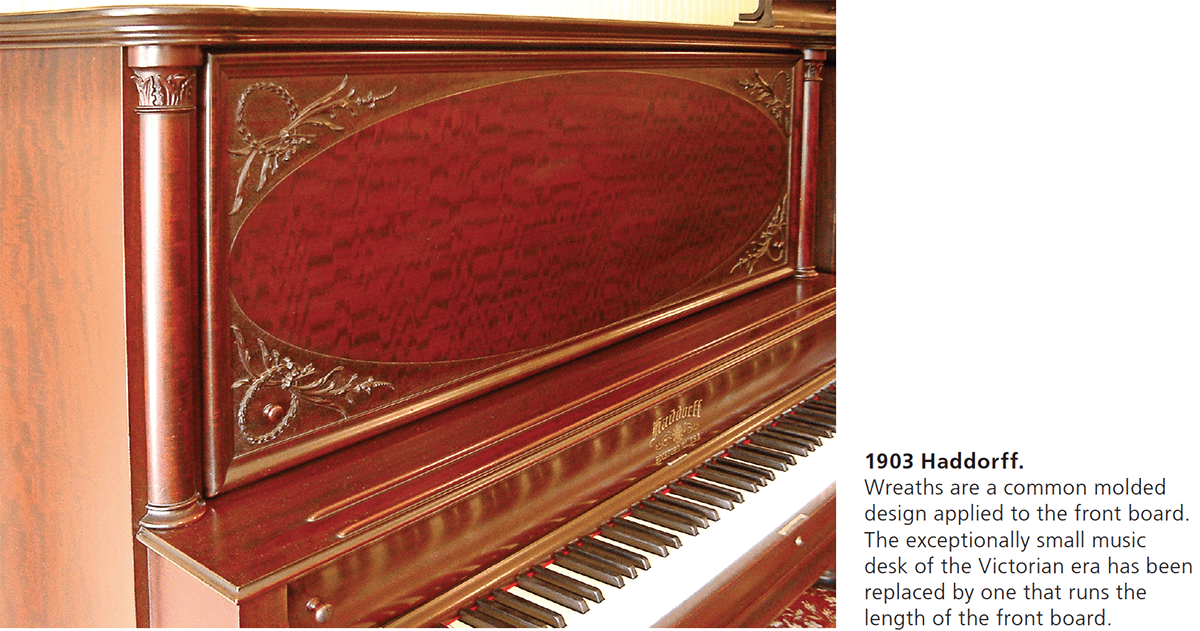
Sheet music, now in plentiful supply, has made the little fold-out music desk obsolete. A wide music-desk shelf now runs the length of the piano, and the front board pivots out at an angle to support the music, which can be spread out across the entire front board.
The fallboards of this era are in two pieces, joined by a hinge, and are usually rounded to correspond to the rounded cheeks. When opened, the fallboard tucks all the way under the music desk.
Rosewood has all but disappeared. The predominant woods are now mahogany and walnut, with a smattering of oak pianos being produced.
There is a great difference in the look of applied moldings from 1900 to 1909. At the beginning of this period, the imitation wood carvings were usually very small and delicate. As time went by, they grew larger and more crude-looking until, about 1909, they were about the size of cow patties. By 1912, virtually all piano cases lacked such ornamentation.
Styles of 1909–1929
With the expansion of the middle class, the demand for pianos skyrocketed, which caused piano manufacturers to modernize and simplify the time-consuming detailing of the piano cases. Removing the ornate carvings allowed them to produce fine instruments at a faster rate and more profitably. Although many fantastic pianos were made during this time, these two decades saw a steady progress toward less expensive, lower-quality instruments.
Pianos of the 1910s and 1920s generally have straight-sided cases with square legs. The early models from this era of change have a front-board design of three inset panels, with architectural molding around the edges. Later, the three-panel design was discarded in favor of a single flat panel. The columns on the sides of the front boards are straight; the cheeks and fallboards are squared.
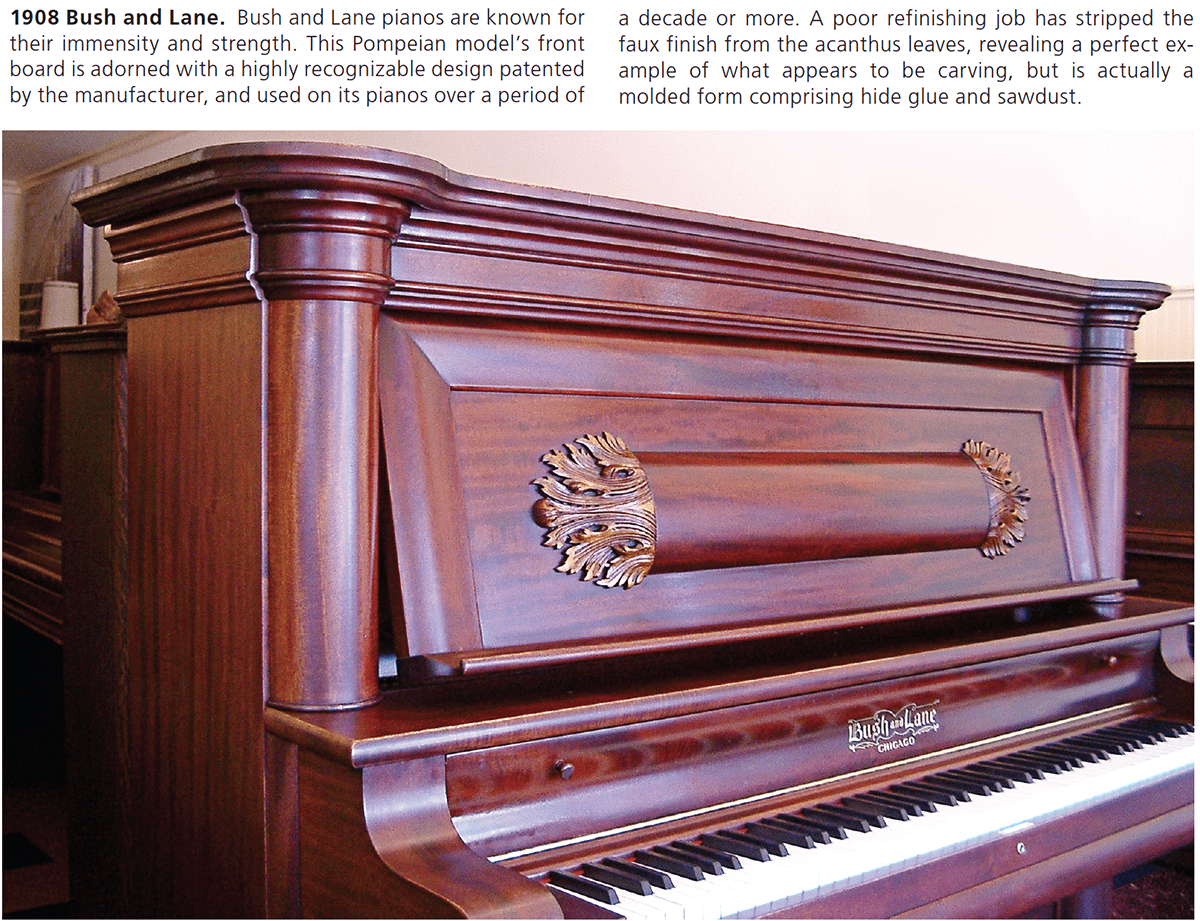
As choice woods became more scarce, there was a subtle but notable change in the veneers of the teen years: Mahogany became less figured, mostly ribbon striped, without the intense flame pattern. Oak, better suited to middle-class homes due to its less-formal look, became more popular. Lower-end pianos were now finished with cheaper varnishes that didn't hold up well over time.
Heading into the 1920s, the quality of ivory used for keytops significantly declined, becoming more translucent, and apt to have a straight grain that looks like milk running down a glass rather than one resembling fingerprints, as in earlier pianos. The presence of celluloid keytops, distinguishable by squiggly lines in imitation of ivory grain running down the key, indicates a lower-priced piano of the late teens and twenties.
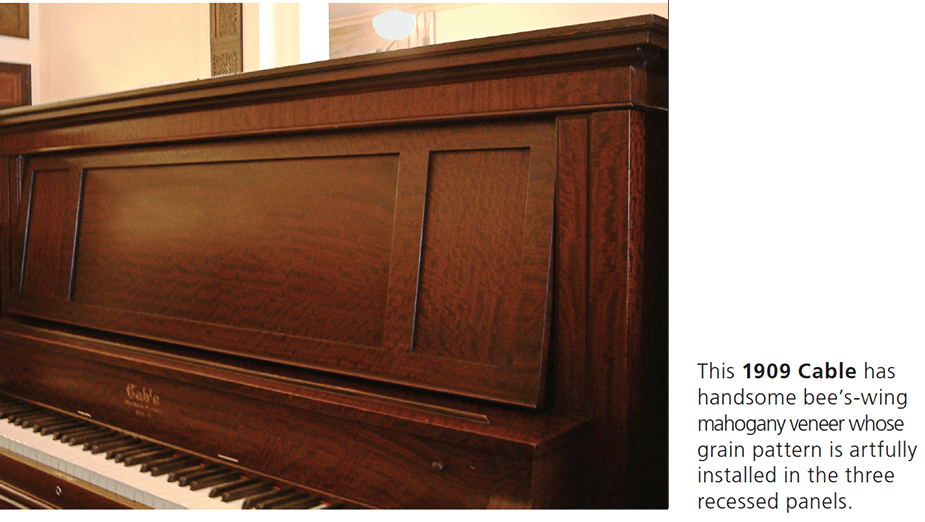
The Arts and Crafts Movement
In England in the late 19th century, and in America from about 1910 to 1920, the Arts and Crafts movement arose in reaction to the Industrial Revolution, mass production, shoddy consumer goods, and the poor treatment of workers. This movement emphasized pride in craftsmanship, and the idea that it was possible to provide both well-made consumer goods for the public and decent employment for workers, without the craftsman becoming a mere cog in the wheel of massive factory production. In England, the movement tended to result in high-priced goods that only the wealthy could afford. But in America, prices were kept affordable by combining the use of factory methods for basic components with handcraftsmanship for assembly and finishing.
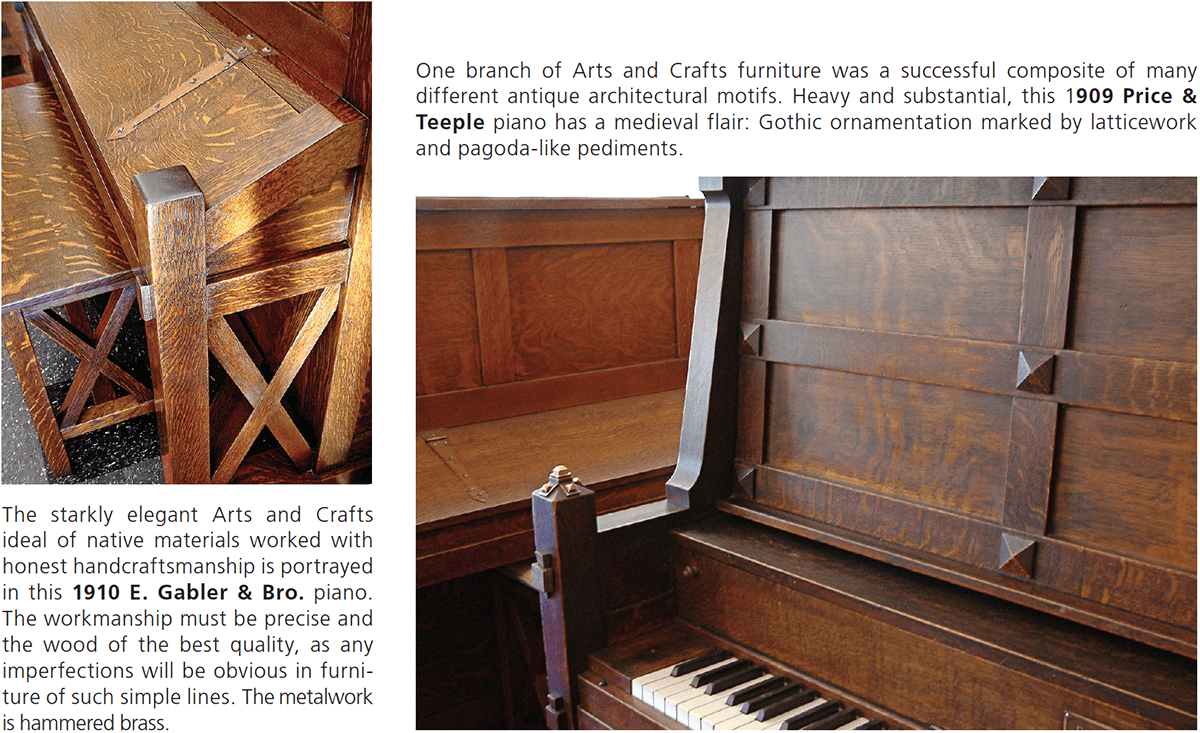
There were a number of furniture styles associated with the American Arts and Crafts movement. The one most often used with pianos, known as the Mission style, incorporated elements of the traditional furnishings of the Spanish and Native Americans of the American Southwest, as exemplified by the basic, solid furniture of the Spanish missions of California. Piano cabinets, usually of oak, were produced with exposed mortise-and-tenon joinery, and included hardware of hand-hammered brass.
World War I and the Roaring '20s
The growth of the piano industry was interrupted briefly by World War I, due to severe material shortages and a tax on luxury goods, but rebounded quickly after war's end, and reached its peak in the early 1920s. The market was glutted with old non-player upright pianos, and dealers took this opportunity to sell into every home a new player piano that anyone and everyone could play, without tedious lessons, time-consuming practice, or even having to pump the pedals — the pumping systems of many models were now electrified.
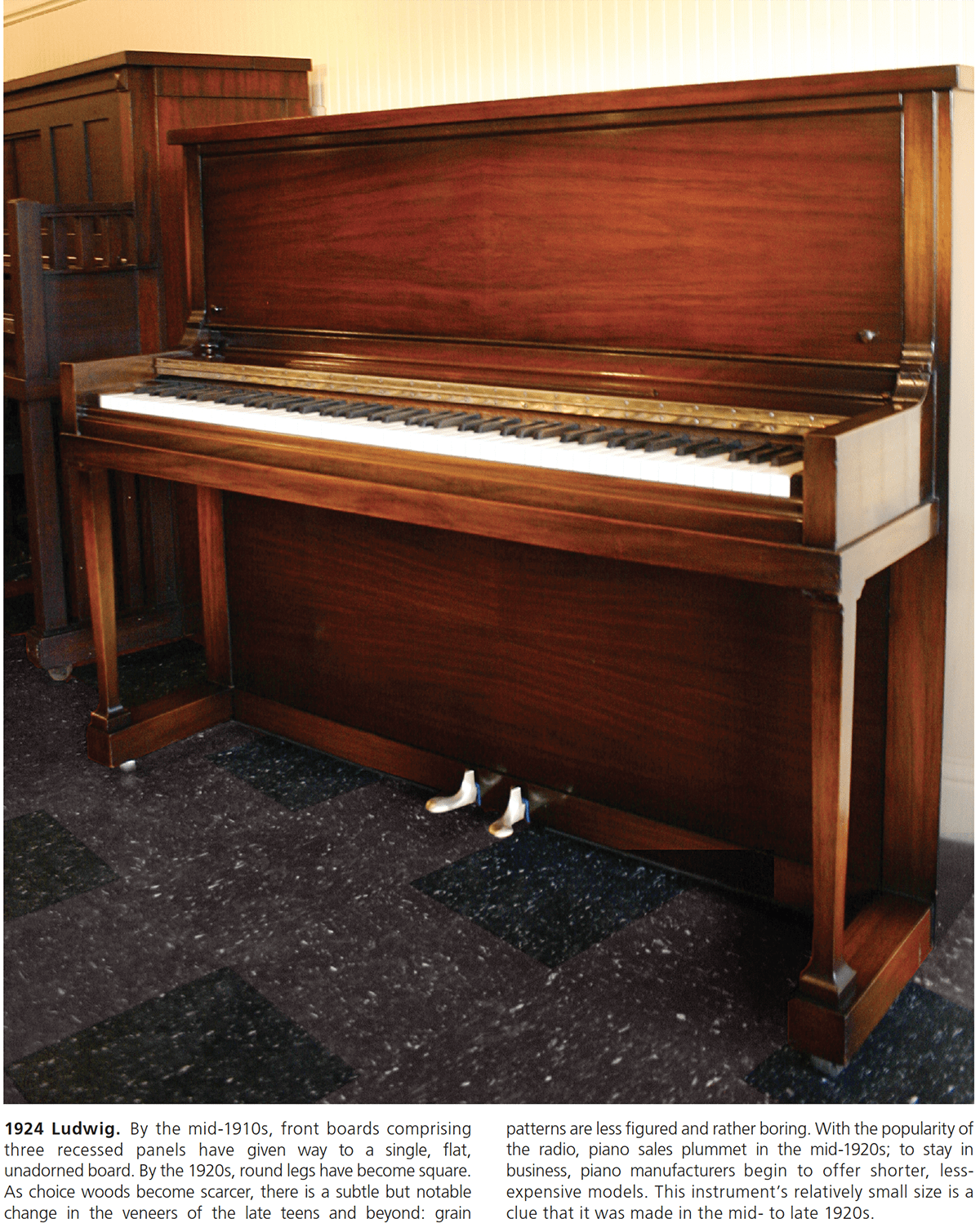
The world was changing at a fast pace, especially the role of women in society. They no longer stayed home being good little girls, doing needlepoint and spending hundreds of tortuous hours in front of the piano. They now had bicycles and automobiles in which to fly about town. There were motion pictures, the "talking machine" (phonograph), and — due to Prohibition — speakeasies. It was an exciting new time in which the piano played an important role, though now less as a symbol of femininity and family values, and more as a passive home-entertainment device.
But the dominance of the piano was about to end. By 1925, the newly developed radio had begun to replace the player piano as a source of home entertainment. A radio was far less expensive than a piano, smaller, and more versatile in the sounds it could reproduce. The decline of the player piano accelerated when, in 1927, the radio was adapted for use with alternating electrical current (AC). Sales of player pianos peaked in 1923, at 200,000 units, but only six years later had fallen to little more than 2,000. As most player pianos had been sold on installment plans, there were massive defaults and repossessions, and warehouses were soon stuffed with unpaid-for, unsellable instruments. In an attempt to stay afloat, from the mid-1920s on, manufacturers began building smaller, less-expensive, studio-size upright pianos.
After 1930
The few piano manufacturers to survive the Great Depression rescued themselves by introducing smaller, less expensive pianos, especially spinets, and consoles in various period-revival decorator styles, to which the public responded enthusiastically. This trend toward smaller instruments lasted for a generation, but was reversed when, beginning in the 1960s and continuing through the 1980s, Japanese and Korean manufacturers offered larger verticals with simple, unadorned lines. The success of these Asian pianos over smaller, fancier American models reflected, in part, a gradual turn toward simplicity, even starkness, in furniture design after World War II, a change to which most American makers did not adapt — and therefore went out of business.
Today's vertical pianos are made in a potpourri of styles: consoles (but no longer spinets) in period styles; bland but functional, studio-size verticals for school use; taller uprights with sleek, straight lines; and hybrid styles. The highly ornamented styles of the past are no longer common, in part because today's mass-production processes make them too costly, and in part because tastes in furniture design continue to trend toward simpler lines; still, some high-end brands offer them in custom-made cabinets. And for those who seek original examples of piano styles past, a few specialist rebuilders continue to restore and make available older instruments. 
Selected Bibliography
Ehrlich, Cyril. The Piano: A History. King's Lynn, Norfolk, UK: Biddles Ltd., 1979.
Good, Edwin M. Giraffes, Black Dragons, and other Pianos: A Technological History from Cristofori to the Modern Concert Grand. Palo Alto, CA: Stanford University Press, 2001.
Loesser, Arthur. Men, Women, & Pianos: A Social History. New York: Simon and Schuster, 1954.
Majeski, Brian T., editor. The Music Trades 100th Anniversary Issue: A History of the U.S. Music Industry. 1990.
Roell, Craig H. The Piano in America, 1890–1940. Chapel Hill: The University of North Carolina Press, 1989.
American Heritage Dictionary, Vol. 17, No 1. New York: American Heritage Publishing Co., 1965.
Correspondence
Dr. William E. Hettrick, Professor of Music, Coordinator of Music History, Hofstra University, Hempstead, NY.